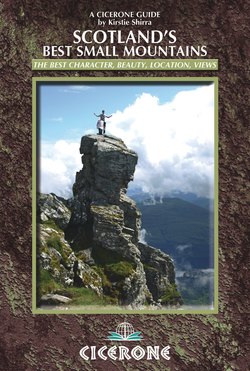Читать книгу Scotland's Best Small Mountains - Kirstie Shirra - Страница 14
На сайте Литреса книга снята с продажи.
Оглавление4
Cul Mor (849m) ‘big back’
| Start | GR 188 093 |
| Distance | 12km |
| Ascent | 760m |
| Time | 4hr30min |
| Terrain | With a good path to start and end, this is a relatively straightforward route, but does involve navigating across some rough, pathless ground, and a steep, rocky final ascent up the ridge to the summit. |
| Maps | OS Landranger 15, OS Explorer 439 |
| Access | Cul Mor is part of the Drumrunie Estate owned by the Assynt Foundation (01571 844100). |
| Getting there | Start at a lay-by on the left of the A835 just past the Knockan Crag car park (188 093). The Ullapool to Lochinver bus passes by Knockan Crag, (Traveline Scotland, 0871 200 22 33, www.travelinescotland.com). |
| Something else | Visit the Knockan Crag visitor centre to find out more about the fascinating geology of the area (01854 613418, www.knockan-crag.co.uk). |
One of the highest peaks in Assynt, Cul Mor’s rocky summit is a window to both beautiful views, and the history of the formation of the surrounding landscape.
The twin peaks of Cul Mor
The ‘big back’ that is Cul Mor rises up from Knockan Crag to the east to overlook Loch Sionascaig and the peak of Stac Pollaidh to the west. Located in the Drumunie Estate, it is now part of the land owned by the Assynt community, who formed the Assynt Foundation to buy the estate and neighbouring Glencanisp in 2005. Together with the smaller peak of Cul Beag, Cul Mor’s rocky flanks dominate the view as you drive north from Ullapool.
While just one of the famous Assynt peaks, and less well known than Suilven and Stac Pollaidh, Cul Mor does sit at the heart of a major geological debate.
The so-called ‘Highland controversy’, over the way the landscape and rocks of Scotland were formed, began here in the 1850s, and has gone on to shape our understanding of the geology of the world. Prominent Victorian geologists Murchison and Geikie argued that the layers of rock in the Northwest Highlands must have formed vertically, younger rocks forming on top of older ones. They dismissed claims from less well-established figures, such as Nicol and Lapworth, that there were in fact younger rocks beneath older ones, demonstrating that there must be horizontal forces at work in the formation of the landscape.
It was not until the 1880s that this latter theory was accepted as correct, and with it the identification of the Moine Thrust. We now know that the Moine Thrust was formed 430 million years ago when Scotland, then part of America, collided with England and Wales, causing huge sheets of rock to be thrust up to the west to form many of the Northwest Highlands’ most recognisable mountains.
Knockan Crag, at the foot of Cul Mor, was one of the most important sites in identifying the Moine Thrust and the horizontal movement of rocks. Today it forms the Knockan Crag National Nature Reserve, and is home to a visitor centre explaining more about the geology and global processes at work on the rocks and landscapes all around us.
Route
A good path leaves the lay-by, heading north to pass to the west of Lochan Fhionnlaidh. It leads you gently up and round the hummocky landscape, with good views back to Knockan Crag.
This good path ends at a large cairn (185 111) at the foot of the wide shoulder of Meallan Diomhain, just over 2km from the start. From here, head west-northwest on a rough, peaty path up the shoulder. It becomes rockier, with the gradient easing at about 500m. The path is hard to spot in places, but continue west with a line of cairns guiding you towards the summit.
Once at the cairn marking the high point of Meallan Diomhain at 600m (170 116), the severe rock crags on the face of Cul Mor make it apparent why a direct ascent from here is not possible. Instead, after taking in the good views southwest to Cul Beag, go north-northwest, descending briefly to head towards the northeast ridge of Cul Mor. The ridge is easily gained by way of rough but not too steep ground.
Knockan Crag
Ascend the ridge, climbing southwest as it becomes increasingly steep and narrow. On the lower section of the ridge you can avoid most of the rocky outcrops, but as you climb, the ridge becomes almost entirely rock, with the final section requiring you to clamber over large boulders to reach the summit trig point (849m) (162 119, 6km, 2hr30). There are great views over the lochs and peaks of Inverpolly, particularly that of Coigach.
To continue, descend gently west then south to the col between the summit and Creag nan Calman. It is then worth the short steep climb to the top of Creag nan Calman (828m) for the views of Cul Beag and Stac Pollaidh.
The easiest descent is to return to the col from here, then head east down the heather and grassy slopes, keeping to the north of the burn. At about 550m, head north and then round to the east to climb briefly back to the high point of Meallan Diomhain. The outward route can then be followed back to the start (12km, 4hr30).
Alternatives
Omitting Creag nan Calman
Rather than continuing to climb Creag nan Calman, return from the summit by the same route (12km, 630m).
